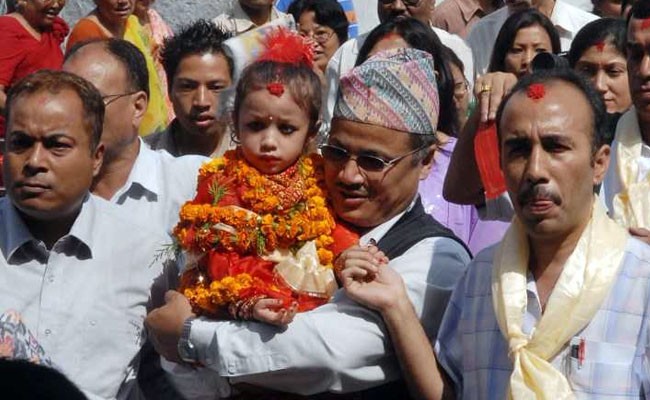Nepal : Tradition of ‘Kumari’ – Three year old is the new Kumari
A three-year-old girl, Trishna Shakya, from Shakya community has been made the new living goddess – “Kumari” of Nepal’s capital city announced the Hindu priests of Nepal recently. The young child was among four finalists from the Shakya clan vying for the position of living goddess, called ‘Kumari’.
Wearing a red dress, Kumari makeup, which includes a ‘third-eye’ painted on her forehead, and the ornate robes of the goddess, Trishna Shakya was carried by her father from her home to a religious ceremony in the ancient Durbar Square in Kathmandu. The three-year-old will live in the “temple Palace” until she reaches puberty.Trinshna Shakya will now be separated from her parents and will live in Katmandu temple Palace under the care of specially-appointed guardians.
On September 28th 2017 the Kathmandu Kumari, Matina Shakya, stepped down and three year old Trishna Shakya, was appointed the new Kumari Living Goddess. As the Kumari, Shakya is considered the embodiment of the Hindu goddess Taleju and will only be allowed to leave the temple 13 times a year on special feast days.
At midnight, Hindu priests will perform an animal sacrifice, which the new Kumari will attend as part of her initiation as a “living goddess”. Historically, 108 buffalo, goats, chickens, ducks and eggs were slaughtered as part of the ritual — a number considered auspicious in Hinduism — but the number has been scaled back under pressure from animal rights activists.
Who is kumari?
The tradition of the Kumari, meaning princess in Sanskrit, Kumari tradition blends elements of Hinduism and Buddhism and the most important Kumaris represent each of the three former royal kingdoms of the valley: Kathmandu, Patan and Bhaktapur.
The Kumari or Kumari Devi comes from the Hindu faith however most of the “traditional” Kumari in Kathmandu are Newari (original settlers of the Kathmandu Valley). In Nepal the Kumari is a prepubescent girl selected by a council from the Newari people that acts as a manifestation of divine female energy.
A Nepali Kumari is believed to be the living incarnation of the goddess Taleju The Kathmandu Kumarialso known as Durga. This continues until after menstruation when the goddess Taleju vacates her body. Illness and loss of blood due to injury can also mean the goddess leaves the girls body.
The idea behind this leads to writings stating that the goddess resides in all female living beings in this universe of which the cosmos was made from her womb. As the goddess believes in chastity and impurity a young child is therefore the ideal choice to house the goddess on earth.
History

Both the Hindu and Nepali histories of the Kumari are vast and intricate dating back 2,300 years to virgin worship in India. There are several legends that tell of how the Kumari came to be in Nepal. According to one story the King Jayaprakash Malla in his dreams saw the Goddess regularly. Another story is that the same King angeried the goddess by making sexual advances towards her and as a penace the King worships Kumari. And according to yet another story the King’s wife learning about the banishment of a young girl possessed by the goddess, asks the King to bring her back to the Kingdom as the living embodiment of the goddess.
Today there are many Kumari in Nepal. Indeed, unknown to many, most Newari villages have a “Kumari”. However it is the royal Kumari of Kathmandu is the most senior and most revered.
The practice was once closely linked to the royal family, but has continued despite the end of Nepal’s Hindu monarchy in 2008.
How a Kumari is Selected

Once the current Kumari is no longer eligible to be a vessel for the goddess a nationwide search begins to find an appropriate successor. There are many criteria that a council of Newari have to make sure are met. These include the thirty-two perfections of a goddess. Some of which are:
A body like a banyan tree
Thighs like a deer
Eyelashes like a cow
Twenty unbroken teeth should be present
Hair and eyes should be very black
Keep in mind these are just some of the necessities in being a Kumari. For example the selection process itself for the Kathmandu Kumari is even more rigourous. During the Kalratri, or ‘black night’ ritual 108 buffaloes and goats are sacrificed.Patan Kumari, Yunika Bajracharya. The young girl is taken into the Taleju temple’s courtyard where the severed heads of the animals are illuminated by candles and masked men dance about. The child must show no fear during any of this.
Finally the girl must spend a night with slaughtered heads of the animals and again show no fear.
And if she passes these tests the girl is taken for ritual cleansing of her past life. Adorned with the Kumari clothes and taken to her new house where she shall remain without seeing her past family until such time as the goddess leaves her (usually her first menstruation).
Life of a Kumari

Once the Kumari enters the Temple palace, she will only leave her residence on official ceremonial duties. Today, due to social change, the Kathmandu Kumari’s family may visit on formal occasions (other Kumari’s live with their families). Her friends will be chosen from those of her caste. She will be educated by her caregivers. Her feet will never touch the outside ground again though on ceremonial occasions worshipers will want to touch them.
Today many politicians and royalty still visit the Royal Kumari seeking a blessing for their duties. One may petition to visit the Kumari but never talk with her. It is believed that a look from the Kumari will tell one’s future wealth, health and status.
In 2008, Nepal’s Supreme Court ruled the living goddesses should be educated and they are now taught inside the palace where they live and are allowed to sit their exams there. Many former Kumaris have spoken about the struggles they face reintegrating into society after they are dethroned.
——————————-
Religion World is one and only indian website to give information of all religions. We are dedicated to present the religions. You can send any info, news, engagements and advice to us on – religionworldin@gmail.com – or you can WhatsApp on – 9717000666 – we are also on Twitter, Facebook and Youtube.









